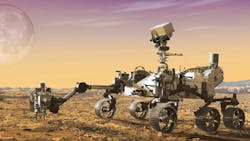Achieving Power Density for NASA Aircraft and Mars Rovers (.PDF Download)
In 2019, small spacecraft with a mass under 180 kg made up almost 7% of all mass launched into orbit. And 63% of spacecraft under 600 kg had mass less than 180 kg—47% of those were CubeSats. Since 2013, CubeSat flights have nearly doubled.
Dedicated SmallSat launch capabilities also create easily available and expanding opportunities to demonstrate new technologies and systems. Powering these satellites is a challenge and power density is crucial.
Beyond the SmallSats, the International Space Station (ISS) and the Mars Rovers face challenges for sustained power, too. Again, power density is a critical issue in these applications. How can designers achieve power density as well as a viable source of power in space for such spacecraft?
